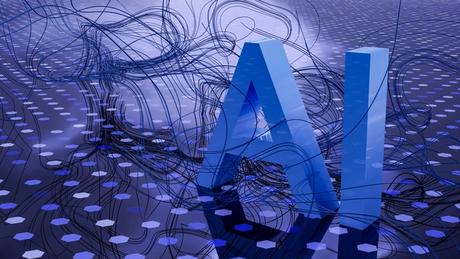Remote Patient Monitoring (RPM): Insights & Innovations
As more healthcare providers adopt remote healthcare, remote patient monitoring (RPM) has become a widely accepted form of healthcare delivery. According to an examination by NPJ Nature on over 7,000 patients across 41 states, remote patient monitoring software (RPM) with nursing care was safe and effective and resulted in excellent outcomes.
RPM is a technology-driven way of providing medical care to patients from afar. It facilitates the real-time collection and transmission of health data. This article will explore what RPM is and how it’s changing the current healthcare landscape for providers and patients alike.
RPM Market Trends & Statistics
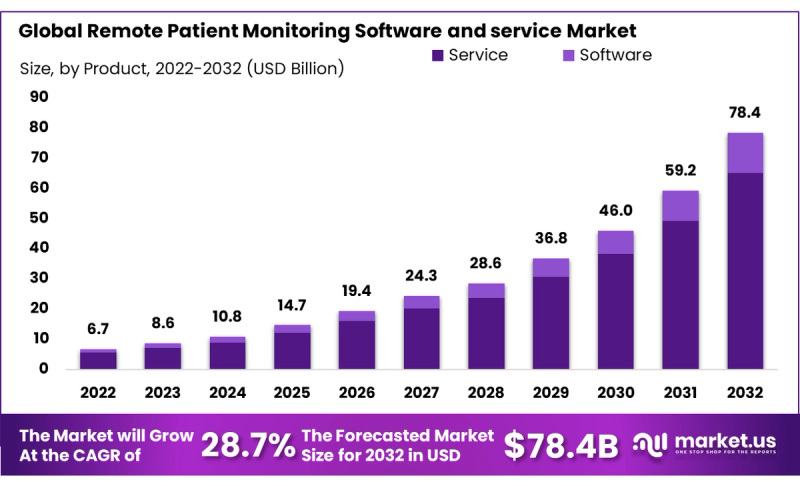
(Source: Link)
The statistics below discuss the increasing adoption rate and market potential of remote patient monitoring in the healthcare industry. They also shed light on the user base, public support, and its considerable role in cutting down hospital admissions and generating financial savings.
- Growing Market: According to a study by MarketsandMarkets, the global RPM market is projected to reach $41.7 billion by 2028, growing at 20.1% annually from 2023. The COVID-19 pandemic also accelerated this growth.
- User Adoption: A Harvard Health Letter article states that 50 million people in the U.S. currently utilize RPM devices, reflecting widespread acceptance and reliance on this technology. Moreover, an MSI International survey revealed that 80% of Americans favor using remote patient monitoring, while nearly half favor incorporating it into medical care.
- Cost Efficiency: Strategic market research reports that organizations utilizing RPM have noted reduced admissions for chronic care complications by 19% to 41%, showcasing significant cost savings and improved patient management.
Now that you understand the importance of RPM in future medical care let's explore remote patient monitoring in detail.
Understanding Remote Patient Monitoring
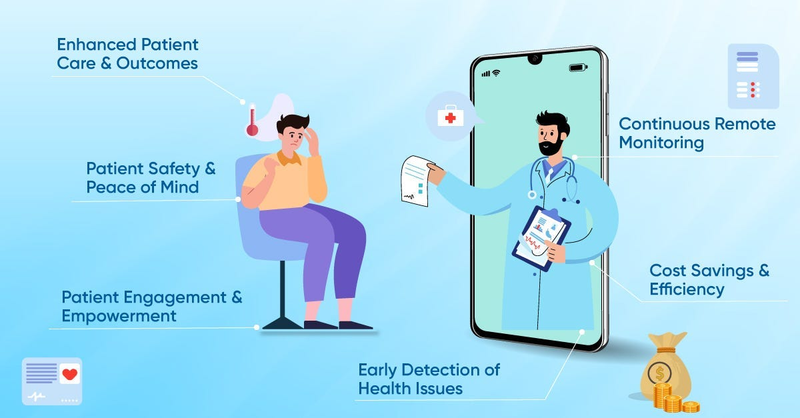
(Source: Link)
What is RPM?
Remote patient monitoring (RPM), also known as remote physiologic monitoring, is a method of healthcare delivery that collects patient data outside of traditional healthcare settings using advances in information technology.
Remote patient monitoring software allows healthcare professionals to manage acute conditions and even chronic conditions. It also helps lower patient travel costs and infection risk. Furthermore, RPM helps promote patient-provider communication and improve patient self-management, thus leading to better health outcomes.
Key Components of RPM Systems
Remote Patient Monitoring, or RPM, is redefining how medical care is provided to patients outside the typical clinical setting—through continuous monitoring within a real-time environment.
Naturally, RPM systems remain incomplete without a crucial set of components that guarantee coherent and secure patient care. Here are the key components of an RPM system:
Monitoring Devices: Blood pressure monitors, heart rate monitors, glucometers, and pulse oximeters are commonly used monitoring gadgets. These medical devices capture and transmit patient information.
Transmission Instruments: These are secure and reliable means of sending patients' information to healthcare providers.
Analysis Software: These analyze the incoming data and identify high-risk patients. They also caution healthcare providers at whatever point an abnormality is recorded so that they can make informed decisions.
User Interface: Accessible stages for both patients and providers to see and associate with the data.
Distinguishing RPM from Related Technologies
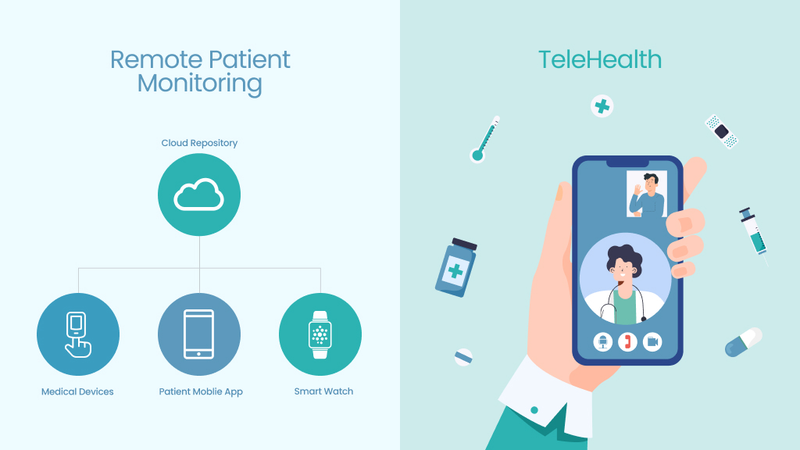
(Source: Link)
RPM, telehealth, telemedicine, patient monitoring—the multitude of terms surrounding the remote monitoring healthcare industry can be a common source of confusion.
So, to help clarify:
Telehealth refers to technologies and Telehealth services that provide patient care and health services over long distances. The means provided by Telehealth services include telemedicine, the use of Telehealth software, and others.
Telemedicine may be considered a subpart of telehealth and can be described as the practice of medicine at a distance. Medical services that may be provided to patients through telemedicine software include virtual visits, medication management, consultation, and chronic disease management.
Remote Patient Monitoring refers to the use of equipment that allows a healthcare provider to monitor a patient and make informed decisions about the patient's treatment when the patient is not in the facility. It is not a part of telemedicine but an aid for patients that works through remote patient monitoring software (RPM).
Patient Monitoring involves deploying medical devices for monitoring in a confined environment, such as a hospital or clinic. Unlike patient monitoring, remote patient monitoring usually involves deploying the monitoring equipment in the patient's home.
What is the importance of Remote Patient Monitoring?
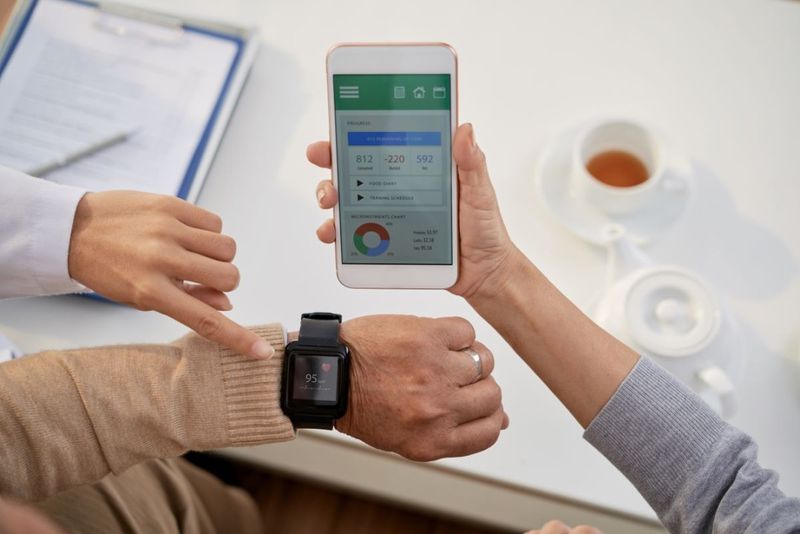
(Source: Link)
Remote patient monitoring technology (RPM) has developed into an integral part of the modern healthcare system, providing many benefits in improving patient outcomes, reducing the cost of healthcare, and helping medical services become more efficient. The following key points underline the importance of RPM:
Improved Patient Results
Consistently monitoring patients will result in early warning of well-being issues. This can lead to timely interventions and better management of chronic conditions. RPM also supports individualized treatment arrangements to ensure that patients receive personalized care.
Diminished Hospital Readmissions
By giving continuous monitoring and quick support, RPM helps anticipate complications that frequently lead to hospital readmissions. Patients with persistent conditions can more successfully manage their well-being at home, lessening the need for frequent clinic visits. This benefit of RPM became even more prevalent due to the constraints of the COVID-19 pandemic.
Cost Efficiency in Healthcare
Remote patient monitoring software diminishes the need for in-person visits and hospital stays. It drives noteworthy cost savings for both patients and healthcare suppliers. By anticipating complications and readmissions, RPM minimizes long-term costs. This, in turn, helps with chronic illness management.
Why is RPM a good strategy for Healthtech Founders?
For health-tech founders, integrating RPM technology into their portfolio is not just about adding a new product but also about embracing a very strategic tool. This tool can redefine the business organization's overall value proposition and market positioning.
Remote patient monitoring software offers a host of strategic advantages that can help start-ups and health tech businesses stand out and scale optimally. It can ultimately succeed in the very competitive health-tech ecosystem.
The demand for Remote patient monitoring software (RPM) solutions is growing tremendously, driven by the aging population. RPM technologies are also a good solution for the growing number of chronic diseases due to unstable or unhealthy lifestyles.
This is a growing market and presents a very promising opportunity for health-tech companies. With the help of remote monitoring healthcare technologies, they will be able to meet a number of unaddressed needs.
By focusing on remote patient monitoring, health tech founders can tap into several new revenue streams and easily expand their customer base considerably. RPM allows for continuous innovation, and this is not only about a path-breaking technology but also about a more innovative way of managing and delivering healthcare services.
By developing unique remote patient monitoring apps that offer advanced data analytics, improved user experience, and/or integration with several other digital platforms, healthcare founders can strongly differentiate their organizations from other competitors.
Innovation in the field of RPM can prove to be a key driver of customer loyalty, brand recognition, and market share. For further questions on RPM and related technologies, it is also advised to look for FAQs related to RPM to better understand it.
Operational and Financial Benefits for Healthcare Providers

Source: Link
Remote patient monitoring software (RPM) is instrumental in revolutionizing patient care. It introduces significant financial and operational advantages for healthcare providers. Here are some important operational and financial benefits for healthcare providers:
RPM enables healthcare providers to monitor several patients remotely, significantly reducing the need for regular in-person visits. This efficiency not only optimizes healthcare delivery but also allows providers to divide resources. Additionally, it enables providers to care for a greater number of patients without compromising quality.
On average, a Congestive heart failure admission costs around $34,000, whereas readmission is around $13,500. Remote patient monitoring has reduced this cost. It has also reduced hospitalization and untimely deaths. It has also improved the quality of life of CHF patients.
Healthcare providers can receive financial incentives through various programs to implement RPM. For instance, Medicare offers reimbursement for providers delivering RPM services, potentially generating more than $1,000 per Medicare beneficiary over a 12-month period for just 20 minutes of monthly monitoring.
How do Remote Monitoring Devices Extend Care to the Home?
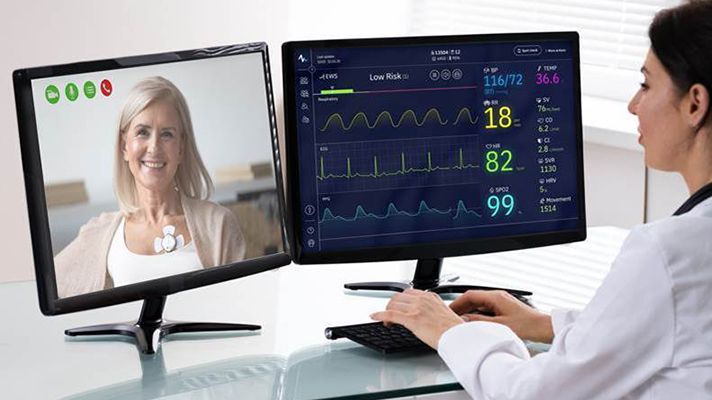
(Source: Link)
Remote monitoring devices play a pivotal role in expanding healthcare access, especially for monitoring patients with mobility challenges or those living in remote areas. Here's how these devices integrate seamlessly into home healthcare:
Comprehensive Home Healthcare Apps: Designed to facilitate medical care at home, a home healthcare app streamlines appointment scheduling, hosts video meetings, and manages medications, making healthcare more accessible and manageable.
Integration with Wearable Technology: Mobile health apps in RPM sync effortlessly with wearable gadgets, such as blood pressure cuffs and heart rate monitors, collecting data on physical activity, sleep patterns, and vital signs. This connectivity and good patient education put patients in control of their health, allowing for continuous monitoring and timely intervention.
Advantages of RPM for Elderly Patients

(Source: Link)
Elderly patients require more intensive healthcare management. When they suffer from chronic health conditions, it becomes very hard for them to travel for medical help. This is where remote patient monitoring lends a hand. Here are the key advantages of RPM for elderly patients.
Enhanced Care and Early Intervention: Top remote patient monitoring software (RPM) platforms allow continuous tracking of vital signs like blood pressure and oxygen saturation. This enables healthcare professionals to quickly identify high-risk patients and address potential health issues, preventing complications and ensuring timely care.
Improved Chronic Disease Management: By monitoring chronic care management software, remote patient monitoring aids in managing chronic illnesses. This includes conditions such as diabetes and heart disease. It provides valuable insights into patients’ health for electronic medical records software (EMR) for care teams to adjust treatment plans and medication. This fosters healthier habits and better disease management.
Increased Independence and Aging in Place: Remote patient monitoring enables seniors to stay home while receiving necessary care, promoting independence. Continuous health monitoring with chronic care management software provides a sense of security, allowing seniors to maintain their freedom and well-being in familiar surroundings.
Implementing an RPM System
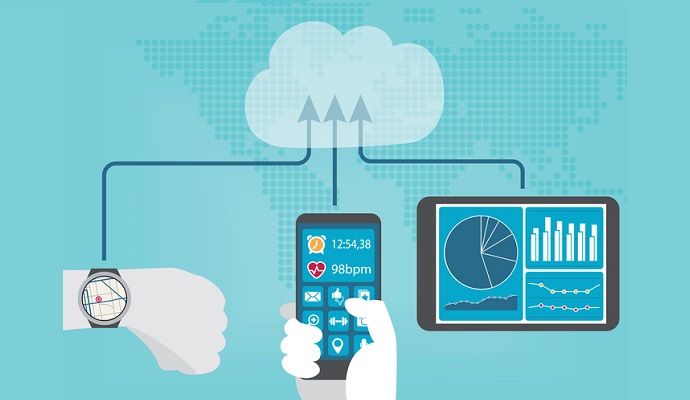
(Source: Link)
Implementing an RPM system includes a few key steps to guarantee effective monitoring and patient engagement:
Initial Patient Assessment
Initial Patient Assessment
First, care providers evaluate the patient to decide which health measurements are required for tracking. They look at the patient's medical history, current health, and treatment goals to customize the RPM system accordingly. This personalized approach ensures that the monitoring plan fits the patient's healthcare needs and helps them stay involved in the process.
Monitoring and Data Transmission
Monitoring and Data Transmission
Once the RPM system is ready, patients use gadgets or wearable sensors to check their health stats regularly. These devices automatically send data to RPM software through mobile apps or electronic medical records software.
Continuous monitoring helps health care providers immediately follow changes in vital signs, medicine use, and severity of symptoms. This proactive approach helps identify high-risk patients, predict problems and gives early help when needed.
Examination and Feedback Using Digital Therapeutics
Data collected from RPM is analyzed using special software called digital therapeutics. This software helps manage ongoing health conditions and improve patient progress and outcomes. Digital therapeutics uses RPM data to create personalized treatment plans, make changes as needed, and provide educational resources to patients.
Healthcare providers use insights from RPM analytics to give timely feedback. They can also adjust treatment plans and empower patients to take an active role in managing their health.
The Role of AI in Enhancing RPM

(Source: Link)
The integration of AI in RPM propels healthcare towards a data-driven model. By analyzing RPM data, healthcare organizations can identify trends, inefficiencies, and improvement opportunities. This continuous improvement cycle fosters a culture of innovation and evidence-based decision-making in healthcare.
Actionable Steps for Healthcare Executives
To leverage the potential of AI in RPM, healthcare executives are encouraged to:
Invest in Advanced AI Technologies: Equip your remote patient monitoring systems with the latest AI tools for enhanced predictive analytics and personalization.
Enhance Data Analytics Capabilities: Develop frameworks to derive actionable insights from RPM data.
Prioritize Operational Efficiency: Automate monitoring tasks to reallocate resources to high-need areas effectively.
Expand Access Through Scalability: Use AI to extend healthcare services to underserved populations.
Foster Continuous Improvement: Embrace a data-driven culture that leverages insights for service enhancement.
RaftLabs' Commitment to RPM Innovation
At RaftLabs, we are committed to fostering a culture of development and learning. Our work within the RPM space reflects this commitment. We have developed secure and scalable remote patient monitoring solutions, such as the PDC app, to assist healthcare providers in superior remote care delivery.
The RPM app addresses various challenges faced by clinics and hospitals, including high operational costs and limited patient care options. PDC provided an efficient solution to enhance communication and patient health management.
The RPM solution we developed included the following:
Scalable and Robust Tech Stack: AWS serverless lambda is used as a backend for a scalable platform. Along with that, React is used to create a highly responsive frontend.
HIPAA Compliance: Assure data privacy and security through strict follow-up to HIPAA regulations.
AI Integration: Leveraging AI for predictive analytics and automated workflows.
User-Centric Plan: Planning an intuitive interface that caters to patients and healthcare units.
Comprehensive Integration: Consistent integration with electronic health records (EHR) for proper remote patient monitoring services and better overall healthcare services.
Using Smart Health Devices: Provide wearable devices that seamlessly connect with the RPM platform. This enables continuous monitoring and enhances home healthcare.
Over 50 clinics received the PDC app within three months. This drove a wave of upgraded patient engagement and better health results. One of our clients, Dr. Smith, a primary care physician, noted, "PDC is incredible for our clinic. It's simple to use, and it helps us communicate better with patients."
You can also check our comprehensive guide on how to build a healthcare app for more information.
Conclusion
Remote Patient Monitoring (RPM) is revolutionizing healthcare every day. It empowers continuous, real-time health management outside conventional settings. As technology advances, RPM will continue to improve. It will enhance patient outcomes, as well as patient satisfaction, and ensure smoother healthcare delivery.
RaftLabs is at the forefront of this innovation, continuously developing solutions that meet the dynamic needs of the healthcare industry. Whether it's improving their existing healthcare solution or building a new healthcare app, we use the latest technologies to create new solutions that meet the growing needs of healthcare providers and patients.
Ready to change your healthcare practice to state-of-the-art remote patient monitoring (RPM)? Contact RaftLabs today, and let's innovate together!
Frequently Asked Questions
What is Remote Patient Monitoring (RPM)?
RPM is the technology driven setup that uses technological tools to keep an eye on a patient when they are not physically in front of their doctor. This enables continuous monitoring of patient health beyond the traditional hospital or clinical environments.
How does RPM improve patient care?
RPM helps health professionals with patient care through real-time health information, proactive treatment of chronic conditions, customized therapy plans, and better adherence to care instructions.
How does RPM offer assistance in overseeing chronic illnesses?
RPM helps in overseeing chronic diseases by permitting healthcare providers to monitor vital signs, indications, and medicine adherence remotely. This encourages early mediation, avoids complications, and advances better disease management.
What are the benefits of RPM in healthcare?
RPM offers a few benefits, including early discovery of health weakening, reduced hospitalizations, progressed patient results, and improved patient engagement through standard checking and timely mediation.
What are the future trends in RPM innovation and adoption?
The future of RPM innovation and adoption includes advanced AI and machine learning algorithms, the increasing popularity of wearable devices, more sophisticated data analytics, and increased regulatory adoption among institutions.
Insights from our team
Ready to build
something amazing?
With experience in product development across 24+ industries, share your plans,
and let's discuss the way forward.




